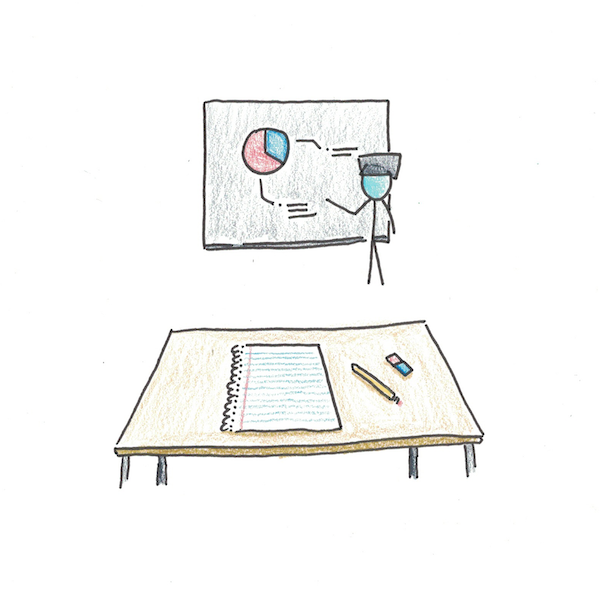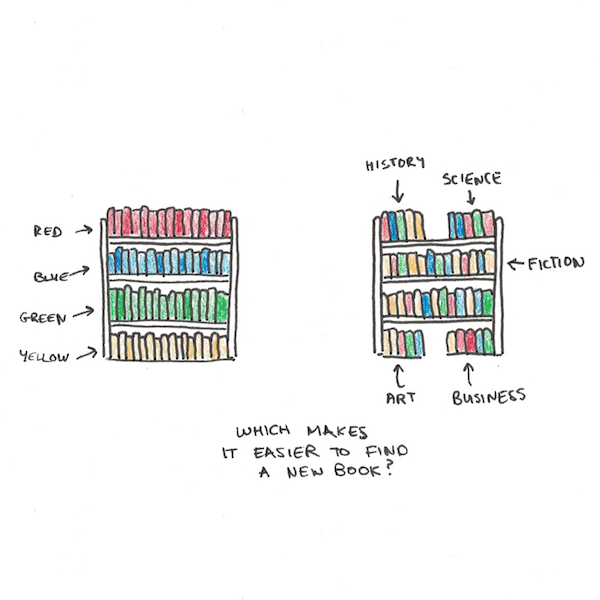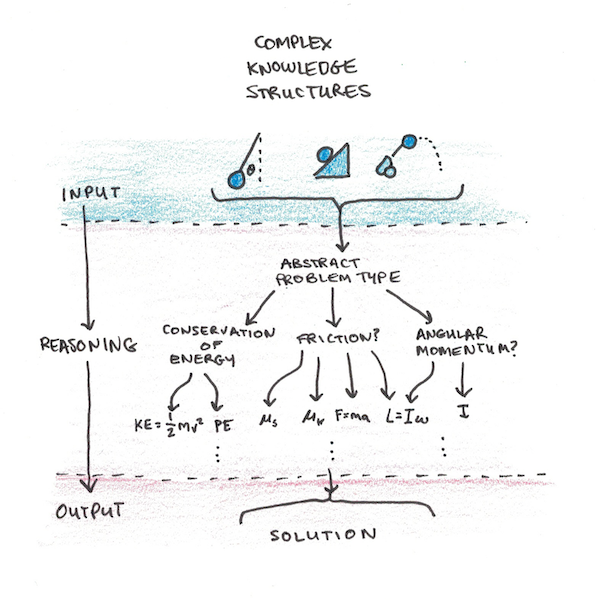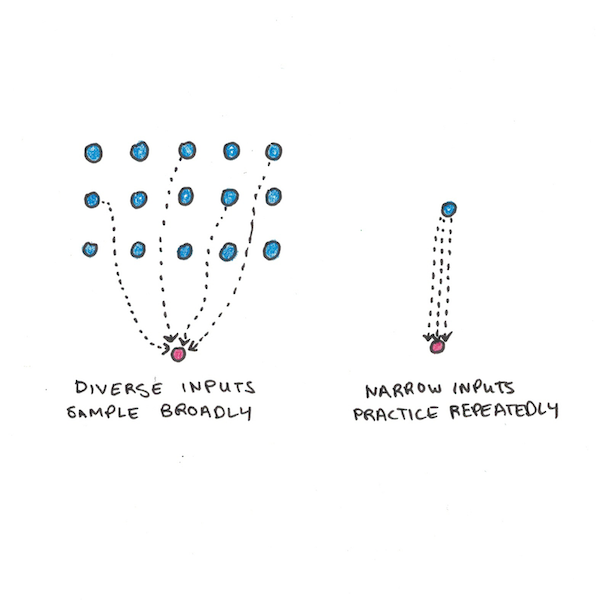Recently, I’ve gotten a lot of emails from students asking the right way to take notes. As I’ve been answering them, I realized that the question of note-taking neatly encapsulates a lot of deeper thinking about the right way to learn things.
Instead of explaining how to take notes, then, I’d like to explain how I think about taking notes. This, it turns out, has a lot to say about how to think about learning anything.
What are Notes For?
The first question with any learning task, be it reading a book, watching a video or doing practice tests, is to ask what you’re trying to accomplish with it.
The way I see it, notes serve two functions:
- They record what you learned, for easy access later.
- They orient your attention, allowing you to remember more.
Most people focus on the first part. Admittedly, this used to be a much bigger problem. Information access was limited, so if you missed an important part of what a teacher told you during a class, you might never get access to it again. Thus notes that form an exhaustive record of what was taught were paramount.
In contrast, I think the second function of note-taking is much more important. What you pay attention to ends up determining the memories you make later. Psychologists call this “depth of processing.” Students who pay attention to deeper features of the material they learn perform better on later tests, than those who focus on superficial details.
Taking notes isn’t just a way of writing things down. It’s a way of orienting your attention so that you’ll build better memories—even if you never open the notebook again.
How to Organize Your Thoughts
What we’re trying to achieve when taking notes is to begin the process of organizing the information we’re receiving into a mental structure we can use later.
The question of how to take notes, then, gets replaced by a deeper one: how should you organize what you’re learning to make it easier to use?
The right way to organize something always depends on the purpose. You could organize your bookshelf by color, for instance, and that might be visually appealing. But it wouldn’t be very good for a friend browsing books who wants to find something by a topic.
Similarly, the way you take your notes is always dependent on how the knowledge will eventually be used. Organized well, and the correct memories will automatically pop up when you need them. Organized badly and you may struggle to retrieve what you need on an exam.
What Kind of Knowledge Structure Do You Need?
We can push our question even deeper: what kind of structure for knowledge do you need to organize?
I like to think of this graphically, like a flow-chart. The end point of learning is to have some kind of structure, so that when you receive certain inputs, you’re able to produce certain outputs.
For some subjects, this structure might be really simple. In a French class, for instance, you might simply have pairs of words.1 An anatomy class might have a diagram with blank spaces and the need to fill in the correct name of a body part.
Most subjects, even those that rely on a lot of rote memorization, have more complicated structures. Sometimes you need to remember groups of information. A historical event might need a place, date, people involved and significance, all linked together. A physics problem might go from determining an abstract problem type, the principles involved and connect to a large library of possible solution techniques.2
Subjects that require “understanding” or “intuition” are typically those with complicated flow-charts. Subjects that require memorization, in contrast, often look simpler but have a ton of elements to recall.
It’s not essential to get a perfect picture of this flow-chart. Indeed, for many classes, you might not even be able to draw one until you already have a lot of experience with the field.
What thinking about learning in this way does, however, is it asks you to try to anticipate how you’ll need to use your mind in order to take advantage of the knowledge you’ve gained. That, in turn, suggests how you should take notes.
Anticipate How You’ll Need to Use Your Mind
What we’re trying to do when learning often comes down to building the mental structures I’ve just described.
This doesn’t mean that you’re consciously working through a flow-chart whenever you speak French or solve a physics problem. Hopefully, if you’ve learned the subject well, the connections simply work automatically. You may even seem to skip over steps as you get better at the subject. Fluent speakers of a second language, for instance, jump straight from meaning to the word, without first bypassing through their mother tongue.
The brain is complicated and so what you’re actually doing when learning and performing is going to be more sophisticated than a flow-chart. But, as a simplification for what you’re trying to do, they often work pretty well.
Whenever I tackle a new subject, one of my first thoughts is what kind of structure am I trying to build. What would be the input situations that should cause me to remember this knowledge? How do I need to manipulate it, discriminate between similar-seeming situations, calculate or reason with it?
If the flow-chart is simple, I might focus on making flashcards. When it’s complicated and I’m not confident I have it figured out, I lean more on practice problems. When my end goal is mostly understanding, I want to try teaching it to someone else (or myself). When my end goal is to solve a practical problem, I should begin thinking about applications.
If the situations where you want to use the knowledge are diverse, I would try to expose myself to as many different examples as possible. If the purpose is going to be fairly narrow, aimed at a specific task, I might want to practice repeatedly to think of it whenever I see that situation.
How to Take Notes
Note-taking is often the first step in a process of learning. You’re usually taking notes when hearing about an idea for the first time or reading about it. The goal isn’t to master the subject completely, but start yourself along the path of figuring out what kind of structure you need to build and to begin building it.
One trade-off that’s immediately apparent is that, for difficult classes, it’s often really hard to keep up with what is being said. For slower, more boring classes, you might have more slack to start trying to mentally organize beyond what is immediately being said.
During a class that confuses me, I might focus more on copying down what is said closely. I expect that I’m going to have to review it when I have more time to actually learn it. On the other hand, a class I understand fairly well, I might want to spend more time thinking about other examples, applications or asking myself deeper questions about the material.
The right way to take notes, then depends on two factors: the structure you’re trying to learn and your ability to work on that structure during the first pass. If you have the structure you’re trying to build in mind, as you listen, however, you’ll be much more likely to pay attention to what you’re learning in a way that benefits you later.
Footnotes
- This is an oversimplification. Pronunciation, grammatical markers and subtleties of usage also matter for actual speaking (one reason flashcards can’t replace actual speaking practice). However, as an approximation, vocabulary acquisition can be seen as a pairing of word and definition (or translation). Otherwise dictionaries wouldn’t be useful.
- Actually creating the full flow chart doesn’t matter. But if you know, for instance, that you’ll be presented with sets of problems and need to reason which principles are involved, set up equations, manipulate algebra, etc.. you’re already off to a good start.






 I'm a Wall Street Journal bestselling author, podcast host, computer programmer and an avid reader. Since 2006, I've published weekly essays on this website to help people like you learn and think better. My work has been featured in The New York Times, BBC, TEDx, Pocket, Business Insider and more. I don't promise I have all the answers, just a place to start.
I'm a Wall Street Journal bestselling author, podcast host, computer programmer and an avid reader. Since 2006, I've published weekly essays on this website to help people like you learn and think better. My work has been featured in The New York Times, BBC, TEDx, Pocket, Business Insider and more. I don't promise I have all the answers, just a place to start.